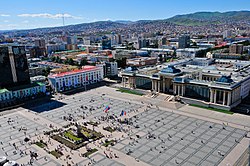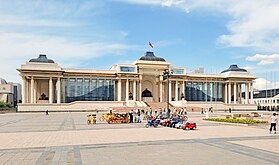| Sükhbaatar Square | |
|---|---|
| Public square | |
| Mongolian: Сүхбаатарын талбай ᠰᠦᠬᠡᠪᠠᠭᠠᠲᠤᠷ ᠤᠨ ᠲᠠᠯᠠᠪᠠᠢ | |
 Sükhbaatar Square Sükhbaatar Square | |
| Surface | Concrete |
| Location | Sükhbaatar, Ulaanbaatar, Mongolia |
| Coordinates: 47°55′08″N 106°55′03″E / 47.91889°N 106.91750°E / 47.91889; 106.91750 | |
Sükhbaatar Square (Mongolian: Сүхбаатарын талбай, Sükhbaataryn talbai) is the central square of Ulaanbaatar, the capital of Mongolia. The square was named for Mongolian revolutionary hero Damdin Sükhbaatar after his death in 1923, and features a monumental equestrian statue of him in its center.
The Government Palace is located to the north of the square, and has a large colonnade monument containing statues of Genghis Khan in the centre, with Ögedei Khan and Kublai Khan to the left and right. The central statue of Genghis Khan is flanked by Bo'orchu and Muqali.
The square's name was changed to Chinggis Square (Mongolian: Чингисийн талбай, pronounced Chinggisiin Talbai) in 2013 in honor of Genghis Khan, but the original name was restored in 2016.
Buildings

Government Palace (built in 1951 on the spot formally occupied by the national theater or "Green Domed Theater") dominates the north side of the square. It is fronted by a large colonnade monument to Genghis Khan, Ögedei Khan, and Kublai Khan, completed in 2006 in time for the 800th anniversary of Genghis Khan's coronation. Prior to its demolition in 2005, Sükhbaatar's Mausoleum, the former burial place of Damdin Sükhbaatar and Khorloogiin Choibalsan occupied the area just in front of the Government palace. On the square's western side sits the headquarters of the Ulaanbaatar Bank, Ulaanbaatar City Administration building, often referred to by locals at "the Death Star" because of its dark exterior, the headquarters of Golomt Bank, the Mongolian Stock Exchange building (formerly the Eldev-Ochir Cinema: 1946–1948), the Mongolian Telecommunications Building, and the Central Post Office. The eastern side of the square is flanked by the Central Cultural Palace Building and State Ballet and Opera House, built between 1946 and 1948, and the Central Towers, a glass and metal skyscraper completed in 2008. Just east of the Government Palace, on the square's north-east corner, sits the former home to the State Printing Press, a white two story building designed by German architect Kavel Maher in the 1920s, which re-opened as the Galleria Ulaanbaatar Shopping Mall in 2018. To the south sits the old Lenin Club building (built in 1929) located right next to the modern sail shaped skyscraper, Blue Sky Tower. Besides the centrally located Sükhbaatar monument, several other statues dot the square's perimeter including one of former president Jamsrangiin Sambuu on the north-western corner, and another for slain revolutionary leader Sanjaasürengiin Zorig across the intersection on the south-western corner (in front of the Central Post Office).
History
Yellow Palace


Throughout the late 19th and early 20th centuries, the grounds of the present day government palace and public square were largely occupied by a temple-monastery-palace complex (the Yellow Palace or шар ордон), which acted as the official residence of Mongolia's spiritual leader, the Jebtsundamba Khutughtu. The temple and its environs were called Zuun Khuree or Eastern Monastery to differentiate it from the Gandantegchinlen Monastery and its surrounding settlements to the west. An open-air field was located just south of the temple complex and was surrounded on all sides by rough-hewn wooden fences and prayer wheels. Beyond that stood temples, residences of the nobility and clergy as well as the Baruun Damnuurchin markets. At the south end of the square stood a red imperial arch with green tiled eaves built in erected in 1883. Mongolian wrestling and Tsam dances were often staged there in the presence of nobles and clergy. Over time, it devolved into a dumping ground of the growing city's refuse. The Bogd Khan would sometimes be seen passing along its edge on his royal procession.
The temple-complex was razed following the Outer Mongolian Revolution of 1921. In 1923 the central square was named in honor of the Mongolian revolutionary hero Damdin Sükhbaatar after his death that same year. The newspaper "Izvestiya Ulanbator khoto" reported on July 15, 1925, that "in line with Mongolian tradition, the fourth anniversary of the People's Revolution was celebrated with rallies at the square dedicated to D.Sükhbaatar". The current statue of Sükhbaatar upon his horse was created in 1946 by the sculptor Sonomyn Choimbol (1907-1970) and is located on the spot where Sükhbaatar's horse allegedly urinated during a rally on July 8, 1921, celebrating the victory of the 1921 revolution. Sükhbaatar's horse urinating was seen as a good omen and a marker was buried on the spot by a man called "Bonehead" Gavaa. In 1946, Khorloogiin Choibalsan had the square paved and had the marker dug out and chose the spot as the place of Sukhbaatar's statue.
National Theater
In 1926 the National Theater, also known as the "Green Domed Theater", was constructed over the ruins of the temple complex. There, Mongolian operas and dramas were staged including works from renowned Mongolian playwright Dashdorjiin Natsagdorj. The theater also hosted party conferences and, during the Great Purge of 1937–1939, was the site of show trials where numerous victims were condemned to death.
Government Palace and Sükhbaatar's Mausoleum


After the theater was destroyed by fire in 1949, Mongolia's leader Khorloogiin Choibalsan ordered the construction of the Government Palace on its site in 1951, which still stands today. In 1954 a mausoleum for Mongolia's national hero Damdin Sükhbaatar was built, in part to perpetuate the cult of personality surrounding one of the nations founders. Modeled after Lenin's Mausoleum in Moscow, it stood on the square's north side just in front of the Government Palace. Sükhbaatar's remains were exhumed from Altan Ulgii cemetery and move to the mausoleum in July 1954, shortly thereafter the remains of Choibalsan, who had died in 1952, were also moved to the mausoleum.
During Mongolia's socialist period, Sükhbaatar Square was the scene of annual civil, youth, and military parades until 1989, with party and government leaders standing atop Sükhbaatar's Mausoleum to view parades on May 1, July 11, and November 7 each year. Large parades were also staged for important visitors, such as when Soviet leader Leonid Brezhnev made an official visit to Mongolia in 1966. The square was the focal point of the Democratic Revolution of 1990 where massive demonstrations and hunger strikes took place. Sükhbaatar Square was also the scene of the violent riots on July 1, 2008 when 5 people were shot dead and many more injured while protesting parliamentary election results. With the abandonment of socialist ideology after the Democratic Revolution and the general development of the city as a result of growth of Mongolia's economy, Sükhbaatar Square underwent dramatic changes, most dramatic of which was the removal of Sükhbaatar's Mausoleum in 2005 and the construction of the colonnade monument to Genghis Khan that replaced it. Between 2005 and 2008 two prominent skyscraper were erected on the squares edges, first Central Towers and then Blue Sky Tower.
Name change controversy
On July 15, 2013, Ulaanbaatar's City Council, then controlled by the Democratic Party, voted to change the name of Sükhbaatar Square to Chinggis Square in honor of Chinggis Khan, whose statue overlooks the plaza from its colonnade portico on the square's north side. The name-change was a political maneuver by Democrats seeking to disassociate the city's central gathering place from not only the previous socialist regime, but also from the opposition Mongolian People's Party (MPP) that represented the legacy of that era - Damdin Sükhbaatar being one of the founders of the MPP. Following the electoral victory of the MPP in June 2016 the square's name was quickly restored to Sükhbaatar Square.
The square today
Today, the square is still the scene of major state ceremonies (including parades in honor of Mongolian State Flag Day or the International Day of United Nations Peacekeepers), cultural events, concerts, and exhibitions. Visiting heads of state generally pay respects in front of the statue of Sükhbaatar.
References
- ^ Sanders, Alan J. K. (2017-08-25). Historical Dictionary of Mongolia. Rowman & Littlefield. pp. Liii. ISBN 9781538102275.
- English News. MN. "Sukhbaatar Square to be renamed after Chinggis Khaan". Retrieved 16 January 2015.
- "Chinggis Square to become Sukhbaatar Square in Mongolia | THEAsiaN". Retrieved 2019-08-19.
- Sanders, Alan J. K. (2017-08-25). Historical Dictionary of Mongolia. Rowman & Littlefield. p. 775. ISBN 9781538102275.
- ^ Diener, Alexander C.; Hagen, Joshua (2018-09-18). The City as Power: Urban Space, Place, and National Identity. Rowman & Littlefield. p. 60. ISBN 9781538118276.
- ^ Aldrich, M. A. (2018-03-02). Ulaanbaatar beyond Water and Grass: A Guide to the Capital of Mongolia. Hong Kong University Press. p. 109. ISBN 9789888208678.
- ^ Aldrich, M. A. (2018-03-02). Ulaanbaatar beyond Water and Grass: A Guide to the Capital of Mongolia. Hong Kong University Press. p. 101. ISBN 9789888208678.
- "'Galleria Ulaanbaatar' to open this summer - News.MN". News.MN - The source of news. 2018-06-12. Retrieved 2019-08-20.
- The Report: Mongolia 2014. Oxford Business Group. 2014-05-23. ISBN 9781910068045.
- Kohn, Michael (2006). Dateline Mongolia: An American Journalist in Nomad's Land. RDR Books. p. 111. ISBN 9781571431554.
- Diener, Alexander C.; Hagen, Joshua (2018-09-18). The City as Power: Urban Space, Place, and National Identity. Rowman & Littlefield. ISBN 978-1-5381-1827-6.
- Rossabi, Morris (2005-04-25). Modern Mongolia: From Khans to Commissars to Capitalists. University of California Press. p. 24. ISBN 9780520938625.
- "ЦЭРГИЙН ЁСЛОЛЫН ЖАГСААЛААР АЛХАЖ, ЁСЛОЛЫН БУУДЛАГА ХИЙЛЭЭ". gsmaf.gov.mn. Retrieved 2021-05-31.
External links
- [REDACTED] Media related to Sükhbaatar Square (Ulaanbaatar) at Wikimedia Commons